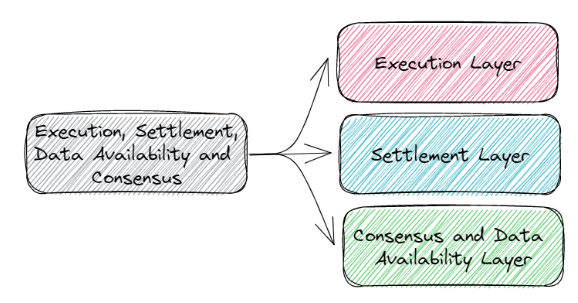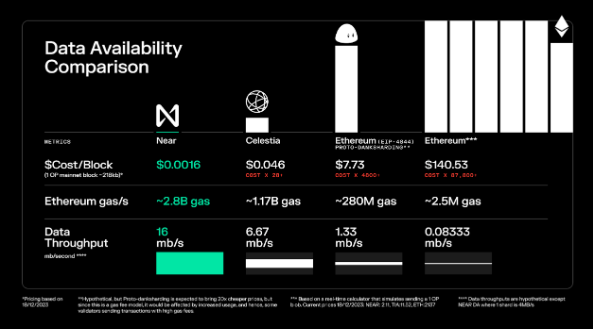Near DA and Super Fast Finality Layer – Near’s push into the Modular Blockchain Space

Modular blockchains are currently a leading narrative in the web3 space, with numerous high-profile launches, announcements, and airdrops taking place. This modular future is not solely embraced by new projects though; Near Protocol has embarked on its own journey in the modular blockchain space, aiming to be more than just another alternative L1.
End of 2023, Near announced two significant developments that work to interoperate and scale Ethereum – Near Data Availability (Near DA) and Super Fast Finality Layer (SFFL) with Eigenlayer. This article briefly examines the benefits of modular blockchain architecture and dives deep into Near Protocol’s solutions.
The promise of modular blockchains
A monolithic blockchain, like Ethereum or Solana, places all of its functionality into a single protocol that runs across the network. In contrast, a modular blockchain divides its functionality into independent components known as modules. With this approach, roll-ups or applications can selectively choose the modules that align with their specific use cases, avoiding the need to conform to a one-size-fits-all blockchain model.

Source: zerocap.com
Near DA and Super Fast Finality Layer are such modules to be used by modular blockchains, developed to solve challenges arising from Ethereum’s basic design. Instead of relying purely on Ethereum, L2s and app-specific roll-ups can incorporate Near’s modules into their blockchain designs. This allows them to select the components that fit their requirements and tailor their blockchain to their specific needs.
Near DA
In the multi-chain paradigm, where transactions are initially processed on Layer 2’s (L2’s) before settling on Ethereum through a rollup transaction, ensuring data availability (DA) is crucial. Data availability guarantees that all necessary transaction data for verifying blockchain states are accessible to nodes during validation. Without these guarantees, network participants cannot independently confirm the validity of blocks, as they lack the complete datasets needed for local transaction execution and result verification.
On Ethereum, full nodes handle this by individually downloading and executing every transaction to validate proposed blocks, keeping the full data available for checking. However, as transaction volumes and state sizes grow, bandwidth and storage demands become very high and impractical.
It is quite expensive to publish the full transaction data onto Ethereum, even in compressed form. EIP-4484, called proto-danksharding, is set to lower the cost of posting data to Ethereum by 10x, enabling Ethereum to function as a more efficient data-availability layer.
Other blockchains, such as Celestia, or Near Protocol with its newly announced Near DA, have emerged as even cheaper data availability layer alternatives for L2’s. These external data availability layers focus exclusively on data storage, replication, serving state snapshots, and ensuring availability for on-chain transaction execution engines.
Execution engines then access necessary data shards on-demand from availability layers during verification without bearing the full replication burden. By centralizing storage with DA layers, data availability—and thus transactions—becomes much more cost-effective.
The downside of this approach is that the guarantee for the data’s correctness now comes from the external data availability layer instead of Ethereum itself. Critics argue that this reduces security.

Source: near.org
How Near DA works
The core part to make Near DA work is a new concept called blobs. Blobs are inexpensive and temporary memory, carrying data about transactions. They are designed to make the verification of these transactions more efficient. Instead of verifying each transaction in the block, the network will only have to confirm that the blob attached to the block carries the correct data.
In practice, these blobs are sequencing data from rollups. When blob data is posted to Near, it remains stored on the network for 3-5 epochs, which equals 36-60 hours. This provides sufficient time for the contents to be verified as needed. After this storage period, the blob is automatically pruned and deleted from Near to conserve space.
However, the data is still accessible indefinitely from archival nodes and indexers connected to the Near network. These independent nodes store historical state and can retrieve old blob data on demand even after deletion from Near itself.
Near DA Integrations
Although only recently announced, Near DA has already achieved integrations with many high-profile networks, such as Optimism’s OP Stack, Polygon CDK, and Arbitrum Orbit. These frameworks allow anyone to spin up their own L2s and leverage Near DA. Specific projects exploring the use of Near DA include Dymension, Caldera, Vistara, Fluent, Movement, and StarkNet.
Near and Eigenlayer’s Super Fast Finality Layer
Ethereum’s roll-up ecosystem provides substantial scaling benefits but suffers from two key issues – fragmented liquidity across roll-ups and poor user experience due to slow finality times. When a user wants to make transactions across different roll-ups, they face high latency while waiting for final settlement on the Ethereum blockchain.
Optimistic roll-ups have a 7-day fraud proof window before a transaction is considered immutable. ZK-rollups are faster but still take around 12 minutes for finality. This negatively impacts user experience.
To tackle these problems, Near Protocol and Eigenlayer have collaborated to build the Super Fast Finality Layer (SFFL). This acts as a mutual coordination layer that roll-ups can integrate with for faster finality and interoperability.
The way it works is that any roll-up can execute transactions as normal, then submit a record of the state update to SFFL. In practice, the claims are submitted to smart contracts on Near. The validators on SFFL (secured by staked ETH from Eigenlayer) come to consensus that the state change is valid. This claim then settles to Ethereum. This step, which takes 3–4 seconds on the SFFL, is in stark contrast to Ethereum’s 12-minute processing time.

Source: Near.org
There is a short challenge period during which anyone can submit a fraud proof to dispute the claims from the roll-up. If a dispute is successful, the state gets reverted, and the validator’s ETH stake gets slashed.
By leveraging Near’s high-speed finality, SFFL enables cross-roll-up transactions to settle much faster from a user perspective. Economic security is maintained through both the NEAR token and ETH staking by Eigenlayer.
In essence, SFFL greatly improves the user experience by overcoming the issues of liquidity fragmentation and slower finality faced by Ethereum roll-ups today.
What does this mean for NEAR Protocol?
It’s important to note that Near Protocol is not fully pivoting away from being an alternative layer-1 chain. Developers can still create and launch their applications directly on Near Protocol. However, Near has shifted its mission from creating a leading layer-1 blockchain to unifying all blockchains into one ecosystem.
With Near DA and SFFL, Near Protocol leverages its fast and high-throughput layer-1 chain to offer new and exciting products. Both new modules offered by NEAR essentially rely on smart contracts, making a fast layer-1 chain crucial for their execution. Near fits that bill perfectly and realizes there is a significant opportunity for them here.
Since all transactions created by Near DA and SFFL rely on calling smart contracts on the Near blockchain, these new products will generate transaction volume on Near. It’s worth noting that 70% of the transaction fees on Near are burned. If the Ethereum roll-up ecosystem continues to grow, cross-chain transactions secured by solutions like SFFL will become crucial to ensuring a good user experience. With many cross-chain transactions between numerous roll-ups, the Near token can potentially experience a significant deflationary effect.
As SFFL is still not launched, little is known about the exact interactions, and no announcement has been made about who will integrate it, quantifying the potential is impossible at this point. However, considering that SFFL will solve a massive problem the Ethereum ecosystem is facing and the fact that SFFL is developed together with the highly regarded Eigenlayer, the potential seems obvious.
Future Outlook
It’s still very early days in the modular blockchain space. There is little data to draw from, and there are few indications of where this field is heading and who will come out on top. However, we can already observe that modular blockchains are quickly becoming a highly competitive field.
With Celestia, Near has a strong competitor on the Data Availability front, and Ethereum’s Dencun upgrade might decrease the appetite for alternative DA solutions in general. However, Near has already established strong partnerships with key players like Arbitrum, Polygon, and Optimism, putting it in a leading position within crypto’s largest ecosystem.
Near and Eigenlayer’s Super Fast Finality Layer (SFFL) also face stiff competition. Optimism and Polygon are both working on their solutions for seamless interoperability. However, all of those solutions require roll-ups to use their respective tech stacks to benefit from that interoperability. For example, the Optimism superchain will only seamlessly connect chains using Optimism’s own tech stack. In contrast, SFFL is neutral and could connect roll-ups using Arbitrum’s tech stack with one using Optimism’s or Polygon’s. It’s easy to see how this versatility can turn out to be a competitive advantage for SFFL.
All in all, it’s very hard to make projections in such early days. Many things are unknown, not yet announced, and a lot of development is still necessary until modular blockchains can hit the market at a large scale. Determining which solution will find the most adoption and best product market fit is impossible to predict at this stage. However, Near DA and SFFL certainly offer compelling products, and the partnerships Near has forged set it up well to become an important player in this new and exciting modular blockchain space.
This article has been written and prepared by Near Foundation/Near Horizon and Lukasinho, a member of the GCR Research Team, a group of dedicated professionals with extensive knowledge and expertise in their field. Committed to staying current with industry developments and providing accurate and valuable information, GlobalCoinResearch.com is a trusted source for insightful news, research, and analysis.
Disclaimer: Investing carries with it inherent risks, including but not limited to technical, operational, and human errors, as well as platform failures. The content provided is purely for educational purposes and should not be considered as financial advice. The authors of this content are not professional or licensed financial advisors and the views expressed are their own and do not represent the opinions of any organization they may be affiliated with.












